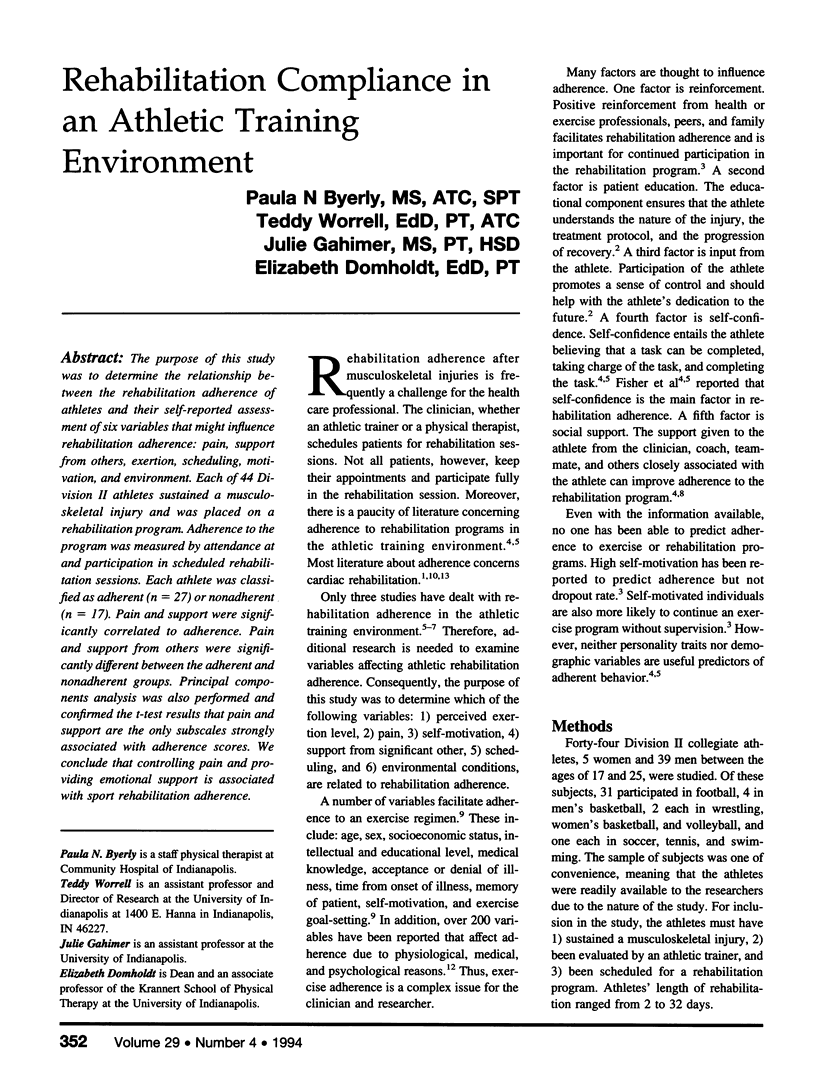Abstract
The purpose of this study was to determine the relationship between the rehabilitation adherence of athletes and their self-reported assessment of six variables that might influence rehabilitation adherence: pain, support from others, exertion, scheduling, motivation, and environment. Each of 44 Division II athletes sustained a musculoskeletal injury and was placed on a rehabilitation program. Adherence to the program was measured by attendance at and participation in scheduled rehabilitation sessions. Each athlete was classified as adherent (n = 27) or nonadherent (n = 17). Pain and support were significantly correlated to adherence. Pain and support from others were significantly different between the adherent and nonadherent groups. Principal components analysis was also performed and confirmed the t-test results that pain and support are the only subscales strongly associated with adherence scores. We conclude that controlling pain and providing emotional support is associated with sport rehabilitation adherence.
Full text
PDF



Selected References
These references are in PubMed. This may not be the complete list of references from this article.
- Andrew G. M., Parker J. O. Factors related to dropout of post myocardial infarction patients from exercise programs. Med Sci Sports. 1979 Winter;11(4):376–378. [PubMed] [Google Scholar]
- Fisher A. C. Adherence to sports injury rehabilitation programmes. Sports Med. 1990 Mar;9(3):151–158. doi: 10.2165/00007256-199009030-00003. [DOI] [PubMed] [Google Scholar]
- Fisher A. C., Hoisington L. L. Injured athletes' attitudes and judgments toward rehabilitation adherence. J Athl Train. 1993 Spring;28(1):48–54. [PMC free article] [PubMed] [Google Scholar]
- Fisher A. C., Mullins S. A., Frye P. A. Athletic trainers' attitudes and judgments of injured athletes' rehabilitation adherence. J Athl Train. 1993 Spring;28(1):43–47. [PMC free article] [PubMed] [Google Scholar]
- Fisher A. C., Scriber K. C., Matheny M. L., Alderman M. H., Bitting L. A. Enhancing athletic injury rehabilitation adherence. J Athl Train. 1993 Winter;28(4):312–318. [PMC free article] [PubMed] [Google Scholar]
- Ice R. Long-term compliance. Phys Ther. 1985 Dec;65(12):1832–1839. doi: 10.1093/ptj/65.12.1832. [DOI] [PubMed] [Google Scholar]
- Levy R. L. Social support and compliance: a selective review and critique of treatment integrity and outcome measurement. Soc Sci Med. 1983;17(18):1329–1338. doi: 10.1016/0277-9536(83)90192-2. [DOI] [PubMed] [Google Scholar]
- Martin J. E., Dubbert P. M. Adherence to exercise. Exerc Sport Sci Rev. 1985;13:137–167. [PubMed] [Google Scholar]
- Oldridge N. B. Compliance of post myocardial infarction patients to exercise programs. Med Sci Sports. 1979 Winter;11(4):373–375. [PubMed] [Google Scholar]


